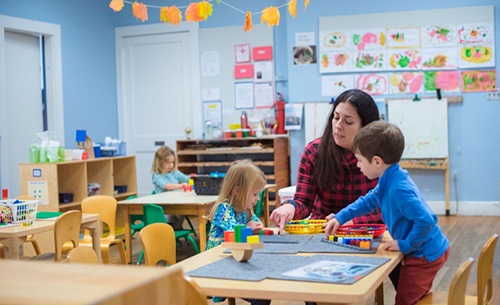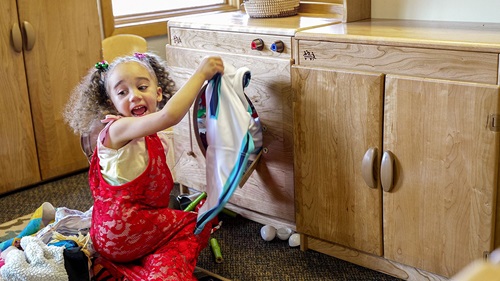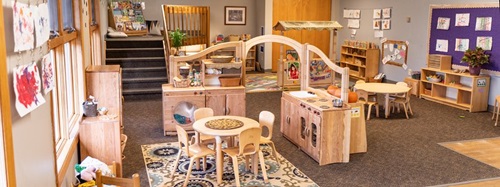Aesthetics in the Classroom Setting
| December 2011
My career teaching young children has taken me many wonderful places in this world, but my classroom has remained in a rather institutional setting. As classrooms go the setting that I teach in is typical: white cinder block walls, cold tile floors, and uniformly straight lines (inside at least). The challenge is making this environment softer and more inviting to children, and adults as well, at an affordable cost. My co-teachers and I have tried many different ways to make our classrooms more of a home for the children. We are still enhancing our environment, which I believe should be a continuing process for any team. The key is flexibility; change is good for continued stimulation in any environment, and it’s a fresh outlook on a new school year. I believe change also prepares children for a world that is constantly in transition.
Color
Color is a very powerful medium. It can invoke warmth, happiness, tranquility, excitement, and any number of other moods. Most people have a favorite color or a color that brings back memories from the past. Color can change the entire look and feel of a space. When someone mentions the color of a space the first thing that comes to mind is paint. Painting is a great way to change an environment, but for most institutional settings there are a myriad of obstacles to this option. Cost could be the number one hurdle as well as approval from the institution or a board of directors. There is also the time factor. When do you paint if the children are usually there? Luckily there are many other ways to change the look of a space with color that are more accessible:
- Quilts on the wall provide color and design as well as softness
- A display of children’s paintings around the room showcases children’s art and is a tremendous self-esteem booster
- Bottles filled with colored water, sand, crayons, glitter adds color to shelves and other flat surfaces
- Reflectors with Velcro on the back are a colorful and creative felt board activity
- Plants add color to any environment and flowers are a great enhancement to the color scheme (they also smell good)
- Toys on shelves in clear bins also create a colorful background and helps the children see what they are choosing.

Flooring
We walk on the floor, we sit on the floor (something most builders don’t think of), but do we really see the floor? Children do, after all they are much closer to it than adults are. In an institutional setting many times the floor is going to be tile with some sections carpeted. The carpet and the tile are usually a neutral color, somewhere between beige and gray.
- Using area rugs in some parts of the room can create more intimate gathering spaces and add color. In the dramatic play area this can create a home environment. In a large group gathering space, an area rug can provide a softer sitting space and form a boundary for meeting times.
- Colored masking tape is a wonderful device for creating art on the floor. With a little imagination and some practice many ideas can be realized. Create an airplane for the children to fly, or a giant insect to inspect. Make a road for trucks and scooters or stepping- stones over a stream.
Ceiling
The ceiling is a vast expanse of nothingness in most rooms. To children it is also an unobtainable height that is a cause for wonderment. Many times children have questioned me, “Can you touch the ceiling?” If you can they are truly amazed. There are ways to lower the ceiling and make it more exciting:
- Many exciting mobiles can be bought, but you can also make mobiles. Old CDs make very glittery mobiles. Natural objects such as pinecones can be hung over a science table. The children can also make mobiles for the room. Use your imagination.
- Umbrellas hung from the ceiling are a very colorful enhancement (with the cloth removed umbrellas become a great frame for a mobile).
- Hanging plants also lower the ceiling.
Nature Inside
Another way to complement an indoor environment is to bring the outdoors in. Plants are an easy first step.
- Create large leaf collages for the walls.
- Or post photos of the natural environment.
- Use mosquito netting (the kind sewn to a hoop for over the bed) hung from the ceiling and secured around a small table, to create a butterfly habitat. It is a great up-close way for children to observe butterflies. After a couple of days release the butterflies and catch new ones. Mosquito netting can also create an intimate spot for quiet play. Place water and food (cut up fresh fruit works well) on the table inside, and then add butterflies that you and the children catch.
- Ant or worm farms are another wonderful idea.
- Classroom pets (that you are comfortable with) enhance an environment and help the children become more responsible.
Soft Spots
In our classroom we have tried to make many soft spots where the children (and teachers) can sit comfortably and relax with a book or a game.
- We have even created a whole area in our classroom called the “Soft Spot.” The children brainstormed and voted on the name of the area. The “Soft Spot” contains a couch (adultsized love seat), a full sized rocking chair, a small table with child-sized chairs, books, games, puppets, and many pillows.
- We also have a “Rest Stop” in our room for two children. There is also a love seat and books in this area.
- Throughout the room we have pillows for the children to relax with, we even have a pillow bed which is a large wooden framed box with pillows on the floor.
Soft spots are wonderful places to read with children or simply to have a conversation. Children who are in group care for many hours of the day need some down time. This is not always easy to come by in a group setting, so any way the environment can be manipulated to include quieter places is a tremendous benefit to young children.

Bathroom
What can I say about the bathroom? Hopefully it is functional and child sized; it is a large part of a child’s day. We have tried to make the bathroom a visually pleasant environment. There is not a whole lot you can do with toilets and sinks. • Adding posters or framed artwork is a simple way to create a pleasant look. We try to change the posters several times a year to ensure continued interest. If you have a child who is just learning to use the toilet, interesting art on the walls may help that child stay a little longer and promote success.
Outside
The play yard can also be a place of beauty.
- Flowering plants and shrubs are always a wonderful addition to any outside environment.
- Sculptures, flags, windsocks, and fountains in a playground entice and amaze children.
- Wind chimes are an incredible way to enhance the auditory beauty of any space (indoors or out).
- Natural wood climbers, playhouses, or tree houses create fantastic new levels to a child’s play, as well as promoting natural beauty.
Odds and Ends
At our homes we have many decorative touches; in our classrooms these can also be implemented:
- Colored bottles along the top of a shelf
- Decorative baskets (for show as well as to hold toys)
- Lamps (where possible) to replace harsh fluorescent lighting
- Decorative strings of lights
- Decorative mirrors for the children to observe themselves
- Books displayed with the covers showing.
- Anything else you can think of to beautify the classroom setting. Think of the classroom as an extension of the children’s home (and yours as well).

Flexibility
When enhancing the aesthetics of your classroom don’t be afraid to experiment. Try new things; if they do not work, try something else. Ask for the children’s ideas; let them know you value their opinions. Get the parents involved; you would be surprised what your families have laying around at home that will look wonderful in the classroom. Try different room arrangements; let the room work for you when it comes to traffic flow and transitions. A well-arranged room can significantly cut down noise and indoor running. Many discipline problems can be eliminated with room arrangement.
Remember, you and the children spend a large part of the day in the classroom so make it as comfortable and inviting as possible. Only make changes and enhancements that you are comfortable with, and learn from mistakes. Most of all have fun with your environment. An exciting and comfortable classroom is essential for any child’s education. The classroom that holds a child’s interest is the first step to a lifetime of learning.
Copyright © Exchange Press, Inc. Reprinted with permission from Exchange magazine. All rights reserved. Visit us at www.ChildCareExchange.com or call (800) 221-2864.






